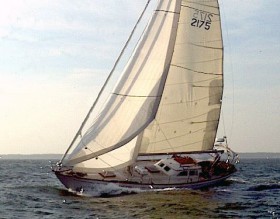Celestial Entry Hotspur II Looks For Clear Sky
 [Written by Talbot Wilson] Ron Wisner is looking for sunny days and starlit nights for this year’s Marion Bermuda Race. He and his crew aboard Hotspur II, his 1968 Columbia 50, will be entered in the Founders Division using only celestial navigation.
[Written by Talbot Wilson] Ron Wisner is looking for sunny days and starlit nights for this year’s Marion Bermuda Race. He and his crew aboard Hotspur II, his 1968 Columbia 50, will be entered in the Founders Division using only celestial navigation.
With Ron electing to celestially navigate, Hotspur II will receive a 2% favorable adjustment to her ORR rating. Wisner and his crew will need to be sure of their position through the Gulf Stream and he can only use his sextant and dead reckoning to do that. Clear skies are important.
“I hope the third time is the charm,” Wisner said after completing his final registration requirements Tuesday at the Beverly Yacht Club in Marion, MA. Hotspur II hails from Marion.
“This is the third time we have entered the Marion Bermuda Race. In 2009 we were sailing Hotspur I, a Pearson 41 yawl. We had 50kt winds in the Gulf Stream section of the race only to get stuck in a drifter at the Bermuda end. In 2011— sailing Hotspur II— we had 30kt winds at the start and broke a lower shroud. We went back into Marion and got it repaired in about an hour and sailed to Bermuda unofficially. This is the third time we’ve entered and the third year I’ve owned this boat.”
“We’ll need to get a good celestial fix going into the Gulf Stream,” Wisner explained. “The current looks like it is strongest just west of the rhomb line (the direct course from Marion to Bermuda) so we will probably aim that way after reaching the ocean. We can’t look at the stream on our chart plotter because we rated for celestial navigation.”
“We can’t turn on our GPS until we are within 50 miles of Bermuda,” Wisner said, “if we elect to do it then. We’ll know we are in the current when the water temperature goes up. We will be pushed to the east and we’ll have to vector our course with estimated set from the current vs. speed. We want to come out near the rhumba line below the stream. With good plotting sights, we can know our position within five nautical miles.”
“We choose to do the celestial sight reductions by hand, not with a computer.” Wisner added. “I think real offshore sailing demands celestial navigation and I don’t feel like I’m really doing it properly unless I’m actually doing the calculations and sight reductions by hand. We will have three sextants and one 1830 vintage quadrant aboard. I’ll be teaching mini navigation classes to the crew at sea.”
Wisner has been using all available data on the Gulf Stream and the weather to pre-plan his route to Bermuda. He is using data from the National Weather Service (NOAA), the Rutgers University Seas Surface Temperature charts and many more sources. The race from Marion is really a four-part process. 1) Getting off the line and out of Buzzard’s Bay and past Sow & Pigs Reef 2) getting down to the Gulf Stream 3) crossing the Gulf Stream and 4) reaching Bermuda after traversing the tricky currents and oft fickle winds of the ‘Happy Valley.’
For some of Hotspur’s II seven-member crew, this is their third try at a prize in Bermuda, but for teenager Bridget Higgins this is her first. When her father Richard, this year’s cook, first sailed to Bermuda on Hotspur I, she wanted to go. Wisner and her dad promised she could go when the time was right. Now at 16, the time is right and she will be aboard.
She is the second youngest person in the 2013 race. According to race entry records, Jonathan Riley on Shindig is 13. He is the son of Mark Riley, a watch captain on the Andrews 68. Follow Hotspur II and all the other yachts in the Marion Bermuda Race on the Yellow Brick tracker program sponsored by Kingman Yacht Center available on the Marion Bermuda website.
All in Bermuda are welcome to share in the post-race festivities and come down to the Royal Hamilton Amateur Dinghy Club to walk the docks and see all of the yachts that have sailed from Marion in the classic ocean race. Celebrate the week of the solstice at RHSADC, Bermuda Style.

